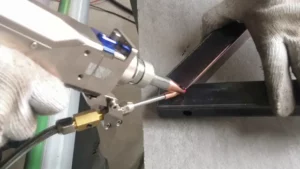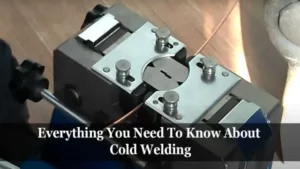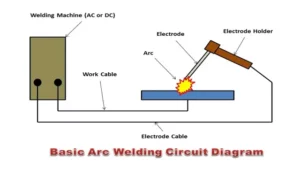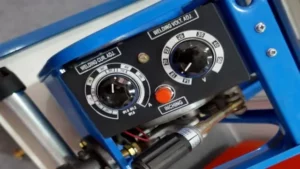MIG welding is a type of welding that uses an electric arc and a wire electrode to fuse two pieces of metal together. It’s one of the most popular welding methods used today because it’s relatively easy to learn and produces a high-quality weld. Using a MIG welding machine may seem intimidating at first, but with a little practice and the right equipment, anyone can learn how to create clean and strong welds.
Have you ever wanted to learn how to weld, but didn’t know where to start? MIG welding is a great place to begin. With its easy-to-use setup and quick learning curve, it’s the perfect method for beginners. MIG welding is also versatile enough to handle a variety of tasks, from automotive repairs to metal fabrication.
Using a MIG welding machine requires a few essential pieces of equipment, including a MIG welder, a wire feed system, and a shielding gas. Once you have your equipment set up, you’ll need to learn the proper techniques for striking an arc, selecting wire and gas, and making a strong weld. Whether you’re a beginner or an experienced welder, using a MIG welding machine can be a valuable skill to have.
With its versatility, ease of use, and ability to produce high-quality welds, it’s no wonder that MIG welding is so popular. So if you’re looking to learn a new skill or expand your welding repertoire, consider giving MIG welding a try.
Introduction
If you’re interested in welding, becoming familiar with a MIG welding machine is essential. MIG stands for Metal Inert Gas, and it’s one of the most accessible and fastest forms of welding. Here’s how to use the MIG welding machine quickly and efficiently.
First, read the user manual thoroughly. Second, arrange all the necessary items such as the MIG gun, welding power source, gas nozzle, and electrode wire. After that, prepare the work surface, wear safety gear, and take the necessary precautions before welding.
Turn on the machine and set the voltage and wire feed speed based on the metal type and thickness. Next, position your MIG gun and the electrode wire towards the joint, and pull the trigger. Weld in a steady, back and forth motion, moving the gun in a circular motion as you progress.
Finally, once complete, turn off the machine and clean your work surface, gun, and electrode wire. That’s all there is to it! With a little practice, you can master MIG welding in no time.
What is MIG Welding?
MIG welding, also known as Gas Metal Arc Welding (GMAW), is one of the most widely used welding techniques in industry and DIY projects alike. It involves the use of a consumable wire electrode that is fed through a welding gun and melted onto the workpiece to create a strong, durable bond. The welding gun also emits a shielding gas to protect the weld from contamination and oxidation, ensuring optimal strength and quality.
MIG welding is versatile and can be used to bond a variety of materials, including steel, aluminum, and stainless steel. One of the greatest benefits of MIG welding is its speed and efficiency, making it a popular choice for projects that require quick turnaround times. Whether you are a professional welder, hobbyist, or DIY enthusiast, MIG welding is a powerful tool that can help you create robust and long-lasting connections.

Benefits of Using a MIG Welding Machine
MIG welding machines offer numerous benefits that make them a popular choice in the welding process. Using a MIG welding machine can help increase efficiency, save time, and increase precision. Unlike traditional welding techniques, MIG welding machines use a continuous wire feed system, which allows for a consistent flow of welding material.
This results in less downtime and increased productivity. Additionally, MIG welding machines are user-friendly and easy to use, making them an ideal choice for beginners. With the ability to weld various materials such as steel or aluminum, a MIG welding machine is versatile and able to handle multiple tasks.
Overall, the benefits of using a MIG welding machine make it a reliable and effective tool for anyone in the welding industry.
Preparing the Machine
If you’re new to welding, using a MIG machine can seem daunting at first, but with a little practice and preparation, you’ll be able to master it in no time. Before you start welding, it’s essential to make sure that your machine is set up correctly. Begin by selecting the right wire and gas.
When selecting wire, consider the thickness of your metal and the type of metal you’re working with. Next, you’ll want to ensure that your gas tank is adequately filled. It’s essential to check the gas levels before you start your project to make sure that you have enough to complete your work.
After setting up your gas and wire, you’ll need to prepare your machine. Make sure that the correct polarity is set, and the wire feed tension is adjusted correctly. Lastly, ensure that you have a proper ground clamp attached to your work surface.
Following these steps will ensure that your machine is prepped and ready for use. Remember to refer to your machine’s manual for additional guidance and safety precautions before beginning your project.
Connecting the Power Source
Before you get started with your machine, one of the first things you’ll need to do is connect the power source. Make sure to read the instructions carefully to ensure that you know where the power source is located, and how to connect it safely. In most cases, you’ll need to plug the machine into a standard electrical outlet, but some models may require a specific type of plug or connection.
Before plugging in the machine, be sure to inspect the power cord for any damage, such as fraying or cuts, as this can be a safety hazard. Next, make sure that the power switch on the machine is in the “off” position before connecting the power source, and never touch the machine or any of its components if your hands are wet. Once you’ve connected the power source, turn on the machine and wait for it to warm up before using it.
With these simple steps, preparing your machine to use should be a breeze!
Checking the Wire Feed
Preparing the machine for welding is a crucial step to take in order to ensure a successful outcome. One important aspect is checking the wire feed before welding. To do this, you should start by adjusting the wire tension so that it’s neither too tight nor too loose.
You want to make sure the wire is able to feed through smoothly without any interruptions. Another thing you can do is clean the wire feeder rollers to remove any debris or buildup that may obstruct the wire’s path. This will help prevent any feeding problems during the welding process.
Additionally, you should inspect the wire itself to make sure it is straight and doesn’t have any kinks or bends that could cause feeding issues. By properly preparing your machine and checking the wire feed, you can ensure a successful and efficient welding process.
Selecting the Right Gas
Selecting the right gas for your welding project is crucial to achieving the desired result. Before starting to prepare the machine, it’s essential to do some research and determine which specific gas is appropriate for the type of material being welded. Gas selection is essential as it can impact the quality of the weld, as well as its overall appearance.
Factors such as strength, durability, and oxidation resistance vary depending on the type of gas used, making it essential to do your homework. One of the most commonly used gases for welding is Argon. This gas is ideal for welding non-ferrous metals such as aluminum, copper, and bronze because it creates a more stable arc and is less likely to cause oxidation.
Using carbon dioxide or a mixture of these two gases is a popular choice for welding steel and other ferrous metals since it gives a good combination of penetration, heat, and welding speed. Ultimately, selecting the right gas will depend on the specific material being welded, and it’s crucial to consider factors such as weld quality, cost, and joint design.
Setting Up the Welding Area
If you’re new to welding and want to know how to use a MIG welding machine, the first step is to set up your welding area. Start with a clean, well-lit workspace that is free of flammable materials. Make sure there is enough space for your welding machine, welding helmet, and other necessary tools.
Next, you’ll need to prepare your welding machine by connecting it to a power source and attaching the grounding clamp to your workpiece. Make sure to check the welding wire for any defects before starting. Once your welding machine is set up, it’s time to adjust the welding settings to your desired amperage, voltage, and speed.
Remember to wear protective gear, including gloves and safety glasses, when working with a MIG welding machine. With the right setup and precautions, you can master the art of using a MIG welding machine in no time!
Selecting the Right Electrode
When setting up for welding, it’s crucial to select the right electrode for the job. This can be a bit of a daunting task, but there are a few things to keep in mind to ensure you choose the best option for your project. First, consider the type of metal you’ll be welding.
Each electrode is designed for specific metals, so make sure you choose one that corresponds with the metal you’ll be working with. Next, take into account the thickness of the metal. Some electrodes are better suited for thicker metals, while others work well with thinner ones.
Additionally, consider the amperage required for the job. If you’re unsure about any of these factors, consult a welding expert for guidance. By taking these factors into account, you’ll be able to choose the right electrode and set yourself up for a successful weld.
Positioning the Workpiece
Positioning the workpiece is a crucial step in welding, as it can affect the quality and integrity of the final product. Before starting, it’s essential to set up the welding area correctly. This involves clearing the space around you and removing any flammable materials that could ignite during the welding process.
You want to ensure that you have enough room to move around and access the workpiece from all angles. Once you have a safe and suitable workspace, you can start positioning the workpiece. The ultimate goal is to place the workpiece in a position that allows you to weld comfortably and efficiently.
Depending on the material and the joint you’re welding, you’ll need to choose the appropriate welding position. This might include horizontal, vertical, or overhead welding positions. Proper positioning of the workpiece can help you achieve a high-quality weld, minimize the risk of defects, and increase productivity.
Remember to also secure the workpiece using clamps or a vise to prevent it from moving during welding. Always prioritize safety and precision in positioning the workpiece to achieve the desired results.
Securing the Workpiece
Before starting a welding project, it’s essential to set up the welding area properly. One of the crucial steps in this process is securing the workpiece to ensure the welds are precise and strong. There are various ways to secure the workpiece, depending on its size and shape.
For example, clamping tools such as vices, C-clamps, or corner clamps are useful for holding the workpiece in place. Alternatively, magnetic clamps or welding magnets may be used if the workpiece is made of ferrous materials. It’s crucial to ensure the workpiece is stable and won’t move during welding, as even a slight movement can result in a faulty weld.
Additionally, it’s important to secure any loose clothing, hair, or jewelry worn by the welder to prevent them from getting caught up in the welding equipment, which can be dangerous. By taking these necessary precautions, the welding area will be set up correctly, minimizing the risk of accidents or mistakes.
Using the MIG Welding Machine
Learning how to use a MIG welding machine is simple and can open up a whole new world of potential projects. The first step is to prepare your workspace and make sure you have all the necessary tools and safety equipment ready. Next, you’ll need to set up the machine using the instructions provided by the manufacturer.
Once everything is in place, it’s time to start welding! Position the welding gun at the desired location and pull the trigger. Remember to keep a steady hand and maintain a consistent speed and distance to avoid any mistakes. MIG welding is a versatile welding technique that can be used on a variety of materials, making it a valuable skill for any DIY-ER or professional.
With some practice, you’ll be able to create strong and precise welds that can withstand even the toughest tests.
Adjusting the Settings
Adjusting the settings on your MIG welding machine is crucial to ensure smooth, efficient, and high-quality welding. Before you start welding, check and adjust the wire feed speed and voltage settings according to the type of material you’re welding. For thin materials, use lower voltage and wire feed speed, while for thicker materials, increase the settings.
Additionally, make sure the polarity is set correctly for the type of wire you’re using. The right settings can make the difference between a clean weld and a messy one with spatter and poor penetration. It’s also essential to monitor the welding arc and adjust the settings as needed to maintain a consistent arc length and prevent burn-through or incomplete penetration.
Remember, practice makes perfect, and don’t be afraid to experiment with different settings to find what works best for your welding needs.
Maintaining the Correct Angle
Maintaining the correct angle is crucial when using a MIG welding machine. The angle of the gun should be between 10-15 degrees from the perpendicular position to the workpiece. This angle ensures that the wire is fed into the joint and melts properly, resulting in a strong and clean weld.
It’s essential to keep the gun steady and move it in a fluid motion across the joint. If the angle is too steep or shallow, it can lead to an improper weld that may break under stress. One way to ensure the correct angle is by having a steady hand and practice.
The more you practice, the more you’ll become comfortable with the angle and the speed at which you move the gun. Another way is by using a welding helmet with a magnifying lens, which helps you see the angle and the weld better. A proper angle not only ensures a strong weld, but it also makes the welding process more comfortable and efficient.
Remember, practice makes perfect, so keep at it, and you’ll achieve the perfect angle with ease.
Feeding the Wire
When it comes to using a MIG welding machine, one of the most important things to understand is how to properly feed the wire. The wire feed is essentially the engine that drives the welding process, so it’s crucial to get it right. First, make sure the wire spool is properly mounted and the tension is set correctly.
Once that’s done, you can begin the welding process by pulling the trigger on the welder’s gun. This will start the flow of gas and wire, and it’s important to keep the gun at the right angle and distance from the workpiece to ensure a consistent weld. The wire should be fed continuously without any breaks or interruptions, so it’s important to keep an eye on the spool and make sure it doesn’t run out.
By understanding how to properly feed the wire, you can create strong, consistent welds that will stand up to even the toughest jobs.
Safety Precautions
When it comes to using a MIG welding machine, there are safety precautions that must be considered to avoid mishaps. First and foremost, welders should make sure to wear protective gear such as welding helmets, gloves, and proper clothing that covers the skin. It is also important to maintain a safe working environment by keeping flammable materials away from the welding area.
Before beginning any welding project, check the machine settings and ensure all wires and cables are correctly attached. Welders must also be aware of their surroundings and potential hazards to avoid accidents. In addition, it is essential to have proper ventilation in the work area to avoid inhaling harmful fumes.
By taking these necessary precautions, welders can ensure a safe and successful welding experience. So, before starting to weld, ask yourself: Am I wearing all the necessary protective gear? Is the work environment free from potential dangers? Am I aware of any potential hazards around me? By considering these questions and following the necessary safety precautions, you can ensure a safe and successful welding project.
Wearing Protective Gear
Protective gear is essential for anyone participating in activities that could result in injury. Whether you’re a professional athlete or just playing a pickup game with friends, wearing the proper gear can significantly reduce your chances of getting hurt. For example, helmets are vital for protecting your head during contact sports like football or hockey.
Shin guards are crucial for soccer players to prevent injuries to the lower leg. And don’t forget about mouthguards, which can protect your teeth and prevent concussions. Even if you are not required to wear protective gear, it’s still a good idea to invest in some for your own safety.
Remember, accidents can happen at any time, so it’s best to be prepared. Don’t take unnecessary risks; make sure you are wearing the proper protective gear for your activity. Your health and well-being depend on it.
Maintaining a Safe Distance
In a time where social distancing has become the norm, maintaining a safe distance is crucial for everyone’s well-being. Safety precautions have become a vital part of our daily routine. We find ourselves constantly using hand sanitizers, wearing masks, and washing our hands frequently to keep ourselves and those around us safe.
It’s not just about keeping ourselves safe, but also about protecting those who may be more vulnerable to illnesses. It can be challenging to maintain a safe distance, especially in crowded spaces, but it’s essential to consider the consequences of not doing so. It’s like driving a car with a seat belt – we may not need it at all times, but we wear it in case of an emergency.
Similarly, maintaining a safe distance is an effective precautionary measure to prevent the spread of germs and viruses. Let’s continue to adhere to safety measures and prioritize the health and safety of ourselves and those around us.
Avoiding Electrical Hazards
Electrical hazards pose a serious threat in both residential and commercial settings, which is why it’s crucial to take adequate safety precautions. One of the most important safety measures to consider is ensuring that all electrical installations are done by licensed professionals. This is because proper installation can directly impact the safety and functioning of electrical appliances and wiring systems.
Additionally, it’s crucial to regularly inspect and maintain electrical systems to identify any potential issues that may lead to electrical hazards. It’s also important to provide safety education and training to everyone who comes into contact with electrical systems to promote awareness of potential risks and hazards. Employing these safety precautions will significantly reduce the chances of electrical accidents and ensure the safety of individuals and property.
Conclusion
To sum it up, using a MIG welding machine is like playing a musical instrument; the more you practice, the better you get. But instead of hitting the right notes, you’re melting the right metal. With the proper safety gear, a steady hand, and a good appreciation for the art of welding, you can create something truly amazing.
Just remember to read the instructions, focus on your technique, and don’t forget to keep a cool head. And who knows, maybe you’ll be the next guitar hero of welding!”
FAQs
What safety precautions should I take before using a MIG welding machine?
Before using a MIG welding machine, always wear protective gear such as gloves, welding helmet, and clothing made of flame-resistant materials. Ensure that the work area is well-ventilated and free of flammable materials.
Can a beginner use a MIG welding machine?
Yes, a beginner can use a MIG welding machine. However, it’s important to take the necessary safety precautions and practice proper welding techniques.
What type of metal can I weld with a MIG welding machine?
A MIG welding machine is suitable for welding a variety of metals, including steel, stainless steel, aluminum, and copper.
What is the difference between a MIG and TIG welding machine?
MIG welding machines use a spool of wire while TIG welding machines use a tungsten electrode. MIG welding is faster, easier to use, and better for thicker metals, while TIG welding is more precise and better for thinner metals.
How do I choose the right wire feed speed for my MIG welding machine?
The right wire feed speed depends on the thickness of the metal and the type of wire being used. Consult the welding machine manual or a welding expert for guidance.
What are some common mistakes to avoid when using a MIG welding machine?
Common mistakes to avoid include incorrect wire feed speed, improper grounding, insufficient gas flow, and improper welding technique.
Can I weld outdoors with a MIG welding machine?
Yes, a MIG welding machine can be used outdoors. However, it’s important to protect the machine from wind and rain and to use proper ventilation to avoid inhaling harmful fumes.






